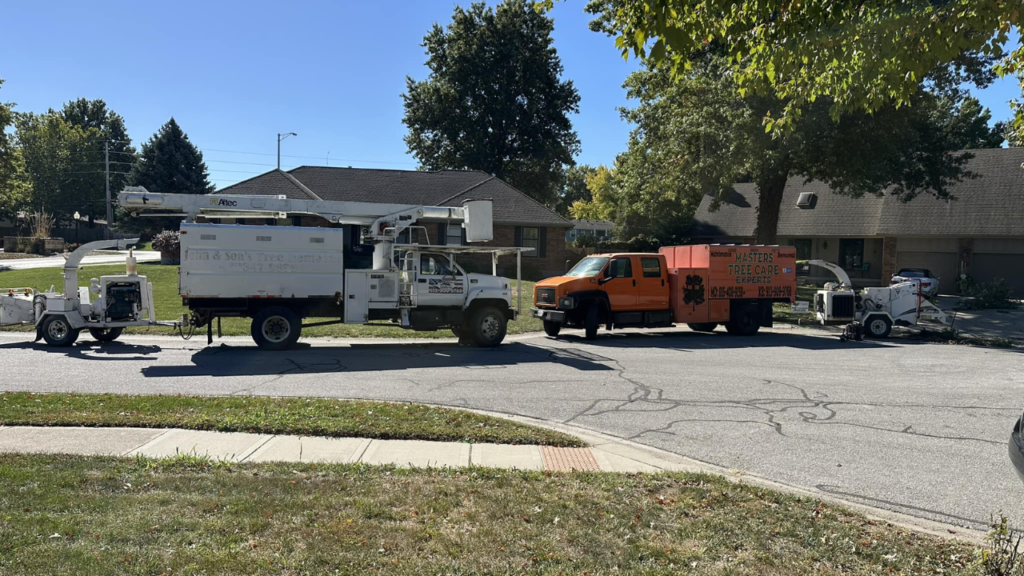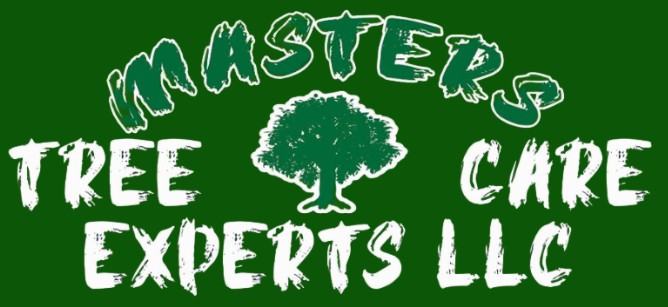Trees are a beautiful and valuable part of any property, providing shade, improving air quality, and enhancing curb appeal. However, when a tree becomes weak, diseased, or structurally compromised, it can turn into a serious hazard. A tree that appears fine on the outside may be rotting from the inside, making it prone to falling unexpectedly. Knowing the warning signs of a dangerous tree can help prevent costly property damage and, more importantly, protect your family’s safety.
At Master’s Tree Care Experts, we specialize in tree risk assessments and professional tree removal services in Overland Park, KS. If you suspect a tree on your property may be at risk, this guide will help you identify the key signs that it may need to be removed.
Table of Contents
1. The Tree is Leaning or Unstable
While some trees naturally lean slightly, a sudden or noticeable lean is often a red flag. A tree that tilts more than 15 degrees from its original position could indicate root damage, soil instability, or structural weakness, making it more likely to fall during high winds or storms.
Signs that a leaning tree may need removal include:
- A recent increase in lean after a storm or heavy winds.
- Exposed roots or visible cracks in the soil near the base of the tree.
- A hollow or decayed trunk, making the tree structurally weak.
If you notice a tree suddenly leaning or shifting, it’s best to have a professional arborist assess the risk before it causes damage.
2. Dead or Hanging Branches
One of the most obvious signs a tree is in trouble is the presence of dead, brittle, or hanging branches, especially in the upper canopy. Dead branches are a serious hazard, as they can fall at any time, posing a threat to people, vehicles, and nearby structures.
Look for:
- Large branches that lack leaves while the rest of the tree is full.
- Cracks, peeling bark, or fungal growth on major limbs.
- Branches that appear dry, brittle, or easily snap in strong winds.
If more than 50% of the tree’s branches are dead, it may no longer be able to sustain itself and should be removed for safety reasons.
3. Visible Trunk Damage or Decay
The trunk of a tree is its structural backbone, and any signs of decay, cracks, or hollowness can indicate severe weakness. Trees with significant trunk damage are at a high risk of failure, especially in storms.
Warning signs include:
- Large cracks or splits running along the trunk.
- Soft, spongy wood or holes in the bark.
- Mushrooms or fungal growth at the base, a sign of internal rot.
- Hollow sections in the trunk, reducing the tree’s ability to support itself.
A tree with a hollow trunk may still be standing, but its internal structure could be severely weakened, increasing the likelihood of collapse.

4. Root Damage and Soil Disturbance
A tree’s root system provides stability and nourishment. When roots are damaged, decayed, or compacted, a tree loses its ability to stand upright and may start leaning or showing signs of stress.
Signs of root issues include:
- Exposed, broken, or decaying roots at the base of the tree.
- Soil heaving or cracks forming around the tree’s base.
- Fungal growth near the roots, indicating rot.
- Trees that are slow to produce leaves in spring or show stunted growth.
Construction, landscaping changes, or underground utility work can disturb roots, making them more susceptible to disease and instability. If root damage is extensive, tree removal may be the safest option.
5. Pests and Fungal Infections
A sick or dying tree attracts insects and fungi, which accelerate decay and make the tree weaker. Infestations of wood-boring insects, such as termites or beetles, can eat away at the trunk and branches, causing irreversible damage.
Signs of pest or fungal problems include:
- Sawdust-like debris (frass) near the base of the tree.
- Small holes in the bark, a sign of burrowing insects.
- White, yellow, or brown fungi growing on the trunk or roots.
- Sudden leaf discoloration, premature leaf drop, or thinning canopy.
If left untreated, pests and fungi can kill the tree from the inside out, making removal necessary before it collapses.
The Importance of a Professional Tree Risk Assessment
While some tree issues are easy to spot, others require a trained arborist’s expertise. A tree risk assessment helps determine:
- If a tree can be saved with pruning, cabling, or disease treatment.
- Whether removal is the safest option due to structural instability.
- How to prevent future tree failures and keep your property safe.
At Master’s Tree Care Experts, our ISA-certified arborists provide thorough tree inspections and risk assessments to help homeowners make informed decisions. If a tree is at risk, we offer safe, efficient tree removal services to prevent potential hazards.
Professional Tree Removal: Protect Your Property and Safety
When a tree poses a danger, attempting DIY removal can be extremely risky. Large trees require specialized equipment and expertise to be safely taken down without damaging surrounding structures. Hiring a professional tree removal company ensures:
- Safe removal without endangering people or property.
- Proper disposal of debris and wood waste.
- Prevention of damage to nearby landscaping or structures.
At Master’s Tree Care Experts, we provide professional tree removal services in Overland Park, KS, using the latest techniques and safety measures to remove trees efficiently and responsibly.
Do You Have a Tree That Needs to Be Removed? Call Us Today!
Ignoring the warning signs of a failing tree can lead to costly damage or even personal injury. If you suspect a tree on your property may be unstable, diseased, or hazardous, don’t wait—schedule a professional tree risk assessment today.
Call Master’s Tree Care Experts at (913) 909-9768 for expert tree removal services in Overland Park, KS. Our experienced team is here to help keep your property safe and your trees healthy. Visit Master’s Tree Care Experts to learn more!

